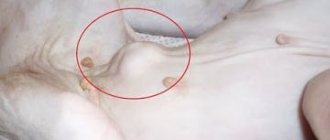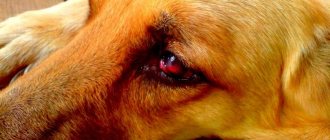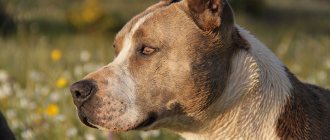What causes red spots on a dog's belly?
Red spots on a dog's belly are easy to notice, since this part of the body is not protected by fur. This symptom can be associated with both serious health problems and non-dangerous conditions in the animal’s life. The appearance of minor redness is not a reason for an urgent visit to the veterinary clinic.
Often the cause of red spots can be contact irritation of the skin from a new overall or an incorrectly selected harness. It is very important to identify the causes of the rash and clearly understand when you can help your pet on your own, and when you cannot do without the help of a specialist.
Main causes:
- Flea and tick bites. The scabies mite provokes sarcoptic mange - a red rash on the body;
- animal, demodicosis - rashes are localized on the animal’s head (around the eyes and mouth);
- Allergic reaction to food allergens, household chemicals and negative environmental circumstances, prickly heat;
- Yeast and fungal skin infection (ringworm);
- Pyoderma is a bacterial skin infection;
- Tumors – benign and malignant lumps;
- Stress factors (neurogenic rashes).
Features of the rash
If you suddenly notice that your pet is somehow not behaving as usual, if you endlessly scratch your stomach (as if fleas have attacked it), legs, and other parts of the body, then you need to carefully examine your pet.
Types of rash:
- Blisters.
- Stains.
- Bubbles.
- Knots.
- Nodules.
- Pustules.
The rash manifests itself in different ways: it may appear on areas of the skin where there is a change in skin color. A rash can be called a spot that is located flush with the skin and differs in color from the normal skin color. If the spots have a varied appearance, this may indicate that the dog has an allergy. Scaly patches can tell you about psoriasis or lichen.
Sometimes a rash on a dog’s stomach looks like a bubble that rises above the skin level and is filled with liquid. This type of rash indicates that your pet has contracted a virus somewhere. Pimples that have a round shape will indicate atopic dermatitis. And this disease can be caused by the body’s tendency to allergies and can become chronic.
This is interesting: Corella Parrot Feeding and Care
Due to unbearable itching, the animal can involuntarily tear apart the itchy blisters. They burst and the wounds become covered with plaques. The next stage after plaques, with prolonged scratching of the sore spot, may be a crust. It appears as a result of all the bubbles bursting and drying out. The rash may indicate signs of serious illness. Diarrhea, vomiting, and fever may appear along with the rash.
Allergic reaction
Allergies can be easily distinguished by the accompanying symptoms. If a food allergen enters the body, increased thirst and vomiting may occur. Contact dermatitis causes contact dermatitis when the bare skin of the abdomen comes into contact with household chemicals. In this case, in addition to reddened skin areas, constant itching will be observed. To help the animal, it is necessary to stop contact with the allergen.
With an unbalanced diet, an allergic reaction can be caused by certain foods, so it is better if the animal’s diet consists of hypoallergenic food.
Some dog breeds, such as pugs, labradors, sharpeis, bulldogs, due to their physiological characteristics, are more prone to allergies.
Prickly heat
At elevated air temperatures, the animal may develop heat rash. Small redness is localized on the stomach and other parts of the body (skin folds and ears). The animal may suffer from anxiety, lethargy, and increased thirst. If the necessary measures are not taken, wet scabs may develop, which then begin to fester.
Causes of red spots in the groin of an animal
The most common cause of this skin pathology is allergic dermatitis. An allergic reaction develops in a dog due to an atypical reaction of the animal to food, household or medicinal components. With allergic dermatitis, the skin takes on an inflamed appearance.
The predisposition to allergies is genetic, and it is also explained by the physiological characteristics of certain breeds. According to veterinarians, the following dog breeds are most susceptible to developing atopy:
- French and English bulldogs.
- Pug.
- Pekingese.
- Chow-chow.
- Dachshund.
In the event of a reaction to any component, the number of spots that appear in the groin may vary from one to several, while the boundaries of the spots may merge. The degree of color of the spots also varies, from a light pink tint to a bright red intense color.
Is it possible to make a diagnosis yourself?
To independently make a primary diagnosis, veterinarians have developed specific instructions. When identifying red spots on the stomach of dogs, you need to proceed according to the following plan:
- Examine the entire body of the animal to assess the area of lesions. Sometimes, upon careful examination, a tick can be identified;
- Observe whether there are any significant changes in the pet’s behavior - repeated thirst, emerging apathy or constant itching;
- Compare the symptoms with the location of the rash;
- If the clinical signs do not correspond to the above diseases, provide the animal with the necessary assistance;
- If it is impossible to identify the cause of the rash or the treatment is not effective, it is better not to delay a visit to a specialist.
It should be understood that most cases of redness on a pet’s body are not associated with the presence of any serious health changes. Dermatological signs of the disease will quickly disappear after treatment with appropriate external agents.
The appearance of red spots in a dog's groin is often accompanied by the development of such unpleasant symptoms for the animal as the development of itching, loss of appetite, sleep disturbance due to increasing anxiety, refusal to drink, and dry nose.
Main symptoms
Skin rashes on a dog are most easily noticed on the stomach due to the paucity of fur, although they can appear on any part of the body. The problem can be revealed by severe itching and general anxiety of the animal, since the rash is accompanied by an inflammatory reaction.
This pathology can develop within a few minutes, as a response to the penetration of an allergen or pathogenic microflora into the body. Therefore, you should pay attention to the following signs:
- severe itching, which is often accompanied by scratching and scratching;
- intense hair loss;
- the appearance of red spots that are hot to the touch;
- general restlessness or lethargy.
If the rash affects the ears, the dog hits them with its paws, constantly shakes its head or tilts it to the side where the affected organ is located, when the inflammation spreads to the middle and inner ear. Puppies may whine, squeal and refuse food.
Types of allergic dermatosis
- Dermatitis caused by the presence of blood-sucking insects on the animal’s body, which primarily include fleas. An allergic reaction develops due to the saliva of a parasitic insect entering the animal’s body during a bite. Almost every dog encounters fleas throughout its life, so the owner’s first reaction to the appearance of red spots in the animal’s groin should be to organize measures aimed at removing blood-sucking insects.
- Dermatitis is of the atopic type, which is characterized by a long-term course and a host of unpleasant symptoms. The development of atopic dermatitis is observed in dogs with a genetic predisposition to this disease. The provoking allergen can be either a food component, plant pollen or a variety of small rodents.
- Dermatitis resulting from direct contact with an irritant. With this type of dermatitis, a red spot is found directly in the area of the animal's body that came into contact with the allergen. Most often, the role of such allergens that provoke red spots are chemical compounds that are part of animal care cosmetics.
- Quincke's edema. Pathology develops when the dog’s body encounters an increased dose of allergens. This is the most dangerous condition for the life and health of a pet, which requires immediate contact with a veterinarian for competent prescription of therapeutic agents.
- A food type of dermatitis that most often develops in those dogs that are fed natural food. Meat can provoke the development of such dermatitis. To get out of this situation, it is recommended to switch the dog to properly selected specialized food.
- Skin diseases such as scabies and lichen can also appear as red spots.
- This symptom may be a direct indication of the manifestation of pyoderma, which is characterized by pustular rashes in the groin area, on the dog’s stomach, and in the anal area.
- Red spots are also characteristic of such complex diseases as tuberculosis, plague and tumor, as well as a number of infectious conditions.
Ways to help your pet
In any case, the appearance of a red spot in the groin signals the start of an allergic reaction. Helping an animal primarily involves promptly contacting the veterinarian who is observing the animal. Taking a course of antihistamines will help relieve the symptoms of the disease. The doctor's prescriptions may include superficial treatment of the affected surface of the dog's skin with ointments or tinctures.
My dog has red spots in his groin: what are they and what should I do?
Most often, the rash is observed on the dog's stomach. This is due to the fact that this area is practically devoid of hair, and any rashes on it immediately become noticeable. The pimples become inflamed, swell and itch, causing the animal considerable discomfort. If red spots appear, other symptoms may also occur: frequent urination and bowel movements, hair loss, hot spots and ulcers on the dog's skin. The pet's behavior also changes.
When scratching with its claws, the dog can introduce infection into the deeper layers of the skin, which will lead to tissue inflammation, an increase in the area of infection (on the leg, on the body) and other unpleasant problems. This is why it is so important to contact a veterinarian in a timely manner.
There are many reasons why dogs have red spots on their belly. Here are the most common ones:
- Parasite bites. The scabies mite causes sarcoptic mange (red spots all over the body, which may appear on the dog's face and ears), demodicosis (rashes are also observed around the mouth and eyes).
- An allergic reaction to protein foods, household chemicals or environmental irritants. Some breeds, due to their physiological and genotypic characteristics, are more susceptible to allergies: Labradors, pugs, bulldogs, dachshunds.
- Incorrect diet using economy-class feed.
- Fungal or yeast infection, such as ringworm. The disease is accompanied by severe itching and an unpleasant odor.
- Hypothyroidism is a disease of the thyroid gland, which is also characterized by lethargy and dry dermis.
- Stressful situations (neurogenic rash). Bloody pimples and spots in the dog's groin appear if it scratches its skin due to anxiety, loneliness, and longing for its owner.
- Various diseases. Dermatitis, plague, eczema, leptospirosis, tuberculosis, malignant and benign neoplasms, pyoderma can also cause spots on the skin in the groin or abdomen.
Before you begin treating a dog’s skin rash, it is necessary to identify the triggering factors.
Yeast and fungi
An infectious skin rash can also occur as a result of fungal infections or yeast. These rashes are very unpleasant and will most likely need to be seen by a veterinarian. With fungal infections, the rash is usually bright red, very itchy, and also has an unpleasant odor. The most common fungal skin disease is ringworm (pictured below). Ringworm causes bright red, round spots, most often on the face and paws. These spots are very itchy and cause dogs to scratch and bite at them. Over time, hair begins to fall out at the site of the spots. Such infectious rashes can be overcome with the help of medicated shampoos and antifungal drugs. Treatment for ringworm will also require disinfecting your home, and the treatment itself can last several months.
Diagnosis and treatment
Often, owners try to remove a red spot on a dog’s stomach on their own, using various anti-inflammatory ointments, as well as practicing traditional methods of treatment: apple cider vinegar, soda. Alternative medicine can help eliminate the itching, but it will not cope with the underlying disease. In addition, there is no guarantee that the products used will not cause allergies in your pet.
Self-medication is dangerous and can aggravate the situation - the disease will continue to develop and the animal’s condition will worsen.
Treatment is prescribed by a doctor based on diagnostics, which includes a visual examination of the animal, asking the owner about the food used, vaccinations, laboratory tests, in particular, a general blood test, skin scraping, biopsy, patch testing (to determine the contact allergen).
There is no single treatment for red spots on a dog’s belly; therapy depends on the specific disease and is aimed at eliminating the root cause. For severe illnesses, certain antibiotics are prescribed.
For allergies, treatment is aimed at increasing the immune response. A special diet is indicated that excludes the consumption of foods that cause the rash. If the animal itches a lot, antipruritic drugs (creams, ointments) and antihistamines are prescribed. In severe cases, products containing steroids can be used, but they must be used with caution to avoid complications with the liver and adrenal glands. For hypothyroidism, hormonal medications are prescribed.
For weeping eczema, drying agents are used, and for dry eczema, moisturizing agents are used. Damaged areas and crusts are treated with disinfectant and antiseptic solutions. Chlorhexidine is very effective in this case.
Symptomatic therapy is used only as an additional measure to the main treatment, but it significantly alleviates the animal’s condition. It is advisable to trim the hair on the dog’s belly, in which case the treatment will progress faster.
To help your pet’s body cope with the disease, it is necessary to use vitamin-mineral complexes and immunomodulators.
Treatment and prevention of dog rash
It is best to have your pet's rash treated by a veterinarian. Ask him if treatment with alternative medicine is possible, which will avoid the side effects of many medications, among which the most common are allergic reactions to one or another component.
A massage using coconut oil will help relieve dry skin and itching. It should be done once a week, allow the oil to absorb into the skin for several hours, and then wash off with a mild shampoo.
Gel or cream with aloe juice (see photo below) is widely used in cosmetics, it can also be used for rashes in dogs. You can purchase ready-made products or prepare the ointment yourself.
This is interesting: Are cats tenacious?
Bathing can provide significant relief from itching, but you must choose the right shampoo. Shampoos with oat extracts are great for dogs prone to skin rashes and also have the effect of relieving itching. However, too frequent bathing is also not beneficial. Healthy dogs are recommended to be bathed once a month or even less often.
Baking soda will help quickly relieve your pet's itching. Dissolve it in water and wipe the affected areas of the body with this solution.
If yeast or fungi are present, you can use apple cider vinegar in the folds of the skin, groin, ears, and stomach. You can wipe the affected areas with apple cider vinegar 2-3 times a week. It is best to consult your veterinarian before using vinegar.
Remember: vigorously scratching, licking or biting the skin rash can cause bleeding and possible infection, so timely relief of itching is extremely important.
Unfortunately, natural methods do not always help to completely get rid of the problem. The use of medications is possible only after an accurate diagnosis has been established and the cause of the rash has been identified. Among these drugs there are shampoos made according to special recipes. They may be prescribed along with oral medications. Such shampoos are effective in combating yeast, bacterial infections, and fleas. It is best to discuss the frequency of bathing your dog with medicated shampoos with your veterinarian.
Steroid medications are often used to relieve itching. They act quickly and give the skin a chance to heal, however, you should not abuse them, because steroids have a negative effect on the liver and adrenal glands.
Antihistamines are used for signs of allergic reactions. However, they will not relieve very severe itching. In addition, it may take some time before the most effective product is selected.
In extreme cases, when there is a risk of various infections entering the affected skin, antibiotics are used.
An infectious skin rash can also occur as a result of fungal infections or yeast. These rashes are very unpleasant and will most likely need to be seen by a veterinarian. With fungal infections, the rash is usually bright red, very itchy, and also has an unpleasant odor. The most common fungal skin disease is ringworm (pictured below). Ringworm causes bright red, round spots, most often on the face and paws. These spots are very itchy and cause dogs to scratch and bite at them. Over time, hair begins to fall out at the site of the spots. Such infectious rashes can be overcome with the help of medicated shampoos and antifungal drugs. Treatment for ringworm will also require disinfecting your home, and the treatment itself can last several months.
Types of allergies
So, allergies happen:
- Food (accordingly, its causative agent is the food consumed);
- Medicinal (reaction to antibiotics, tablets, drops, etc.);
- Exposure to cosmetics or other dog grooming products;
- Infectious (caused by third-party organisms);
- Reaction to insect bites or other parasites;
- Autoimmune (very rare);
- Rest.
A common symptom of all types of allergic reactions in dogs is itching, inflammation and redness of the skin. It is not always possible to notice this, since the skin is hidden by fur. That is why it is necessary to regularly examine the animal.
Signs of food allergies
- Hair loss – hair is lost not evenly throughout the body, but in patches. As a result, so-called bald spots are formed, which, without receiving proper treatment, begin to progress: to grow. However, hair loss does not always indicate an allergy; it can also be a symptom of more serious diseases. Such, for example, as: folliculitis and hypothyroidism.
- Itching - the dog itches intensely and very often (as already mentioned, it is impossible to determine the presence of an allergy, much less its type, by this sign alone).
- Redness – under the fur, the skin has a pronounced pink or red tint.
- Dandruff is definitely an allergic sign. The skin is literally strewn with white particles (dandruff). Although this may also indicate dermatitis.
- Excessive dryness and roughness of the skin.
- The unpleasant body odor is slightly sweetish, not so noticeable at first, but as the allergy progresses it becomes more intense and pungent, almost unbearable.
- Sweat – The chest and armpit areas sweat. Sweat, like the previous symptom, becomes more pronounced over time. In special cases, wet spots remain on the surface. Sweating is generally not typical for dogs; it is a sign of an unhealthy process in the body.
- Often the dog begins to shake his ears and scratch them, the ears become filled with a dark substance and become inflamed. Erect ears droop. This is a sign of otitis media, which in most cases is a consequence of food allergies.
- Tears - the dog’s eyes are constantly wet or white (sometimes brown or yellowish) lumps form in their corners (this may also indicate entropy).
- The smell from the mouth is unpleasant, often putrefactive. In addition, the dog's lips and gums sometimes become covered with ulcers, boils, or are simply inflamed.
- Symptoms found in small numbers indicate the chronic nature of the allergy. The animal must be shown to a veterinarian immediately.
Ignoring problems can lead to serious, so-called secondary consequences as a result of scratching and biting the skin.
Dermatitis (caused by fleas)
The most common allergy. Its manifestation is not distinguished by any special symptoms: the dog itches, its skin is inflamed and has a reddish tint, and subsequently so-called papules form. They are localized mainly in the groin and sacrum areas. After a long period of time, the skin becomes drier and “overgrown” with white dandruff. This reaction is caused by a special substance contained in the saliva of fleas.
Allergic contact dermatitis
Also one of the most common types of allergic reactions. The main difference between its symptoms and the signs of other diseases is the localization of inflammation, itching and pustules strictly in areas devoid of fur. Namely:
- Stomach;
- Groin area (scrotum);
- Feet;
- Chin.
Atopic dermatitis
According to veterinary statistics, it is the second most common disease in dogs. It has no characteristic features: it is also accompanied by itching, inflammation, redness, ulcers, hardened crusts, etc. However, a similar phenomenon is observed mainly in dogs aged from six months to three years.
The first area to be affected (again, only according to observations, not with 100% probability) is the ear area. After which inflammation begins on the face, paws, groin and axillary areas. A common sign is the dog’s constant and nervous licking of the listed places.
Staphylococcal dermatitis
An extremely rare form of allergy to bacteria produced by the body’s own body can be either an independent disease or a consequence of some form of dermatitis. It is accompanied by redness and quite severe itching, but over time, purulent wounds form on the skin in the area of the tail, groin and sub-pectoral area. The extreme stage is boils, ulcers, enlarged lymph nodes. Everyone is individual, so manifestations may vary slightly.
Urticaria – drug allergy or reaction to stings
An uncommon occurrence. Red swollen areas appear. Two main and very characteristic features are localization on the muzzle and smooth, precisely defined edges of redness. The rash disappears after literally a day, but after a while it returns and disappears again. Thus, urticaria permanently torments the animal, but the owner may simply not notice it.
Otitis in dogs
The following types of otitis media are distinguished:
- Allergic;
- Caused by untreated disease.
It affects the ear areas, both external and internal. Identifying a sore ear is quite simple: the dog often tilts its head in its direction. Otitis is accompanied by the following symptoms:
- Warm or hot ears;
- The dog constantly shakes its head or scratches the skin near its ears;
- When pressure is applied to the base of the ear, the animal begins to worry and (in advanced forms) feels pain, whines and breaks out;
- The inside of the ears is inflamed and has a bright red (sometimes pink) color;
- If left untreated for a long time, mucus, white, clear or brown, begins to come out of the ears. Sometimes the discharge is purulent;
- Decreased appetite;
- Lack of activity;
- High body temperature;
- General lethargy.
According to research by experts, dogs with large and “droopy” ears are most often susceptible to otitis media. Those animals whose ears are small, standing or cropped do not have such reactions.
Other accompanying symptoms
- Signs that do not clearly characterize any allergy, other than itching and redness, include diarrhea. It can be either a reaction to a food allergy or a consequence of an advanced state of another type of allergy.
- Sometimes there is a frequency of stool, but it is not necessarily liquid.
- The gums become bluish or gray.
However, to obtain an objective picture, these signs must be considered only in conjunction with others.
Manifestation
The problem comes out in different manifestations. Common symptoms:
- local redness (mouth, abdomen, armpit area, between the paw pads), rashes, discoloration of the epidermis;
- dryness or, conversely, increased moisture of the skin;
- discharge from the eyes, ears;
- swelling;
- itching (of varying intensity);
- sneezing, coughing.
The effect of the stimulus is manifested through a single sign or a set of symptoms. The animal’s well-being depends on the aggressiveness of the component and the frequency of interaction. At the initial stage or with a sluggish course of the disease, the problem is sometimes invisible.
Most often, Samoyeds suffer from acute reactions to insect bites, environmental substances, and food.
Consequences
If the manifestation of an allergic reaction in humans is limited, as a rule, to a runny nose, sneezing or small rashes on the skin, then in dogs this process occurs somewhat differently. The skin itching in animals is much stronger, it is almost impossible to notice it in time. A dog, scratching the affected areas, cannot control its own strength and sometimes causes itself not only damage to the outer covering, but also more serious injuries.
In the absence of at least a little treatment, the disease progresses rapidly, not only causing inconvenience and physical pain, but also affecting more and more new areas of the body, of which the groin area and muzzle are the most vulnerable.
On a number of sites devoted to this topic, you can read information about the relative safety of allergic reactions and how to eliminate them on your own. To think this way is to harm your own pet. Indeed, some signs of allergy are invisible to the owners and pass without a trace: the dog itches for some time, after which its body eliminates the causative agent of the infection. However, these are only positive cases.
Perhaps one of the most terrible consequences is allergic anaphylactic shock. The dog's breathing becomes difficult and can develop into suffocation, which often leads to death in the absence of emergency help.
As already mentioned, it is necessary to regularly carry out at least a superficial examination of the pet: part the fur, look at the ears, check the condition of the mucous membranes. Such simple and painless measures will help identify allergies in its primary stages. However, it must be remembered that the manifestation of any general or single symptom cannot correctly and unambiguously indicate the type of allergy, on the definition of which further treatment will depend. In addition, dog allergy symptoms usually vary from person to person. Therefore, the owner’s first action after detecting a symptom is a trip to the veterinarian.
May your dog always be healthy!
Author of the article: Zoya Egorova
Diseases manifested by skin rashes
In addition to the factors listed above, there are diseases that cause rashes in puppies and adult dogs. These include the following.
Sarcoptic mange and demodicosis
Caused by microscopic mites that parasitize in the layers of the epidermis and under it. In this case, the dog's hair falls out and a rash appears in the dog's groin, limbs, face and other parts of the body. Gradually, the pathogens spread throughout the body and penetrate the internal organs, destroying them and leading to death. Separately, it is worth noting mites of the genus Otodectes, which infect the ears of animals and cause dermatitis, rashes and purulent inflammations.
Trichophytosis and microsporia
These diseases are caused by pathogenic fungi. In this case, hair loss occurs, a rash, red spots, an unpleasant odor and severe itching appear.
Staphylococcal infection
It manifests itself as an inflammatory reaction on the skin, in which pustules form. Staphylococcus aureus can also affect internal organs, the ears, and sometimes even leads to facial paralysis. During the active phase of pathogen reproduction, staphylococcal pyoderma (23) can be observed, in which a rash is noted on the dog’s stomach, crusts form, and the skin becomes red and inflamed. The pathology is accompanied by severe itching.
Carnivore plague
The skin form of the disease is characterized by the formation of small red spots covering the belly, ears, area near the nose and mouth. Gradually, in place of the spots, pustules appear, filled with pus or serous exudate, which, bursting, form dried brown crusts.
Leptospirosis
A dangerous disease manifests itself as hemorrhagic rashes on the skin.
Tuberculosis
It is marked by the formation of red spots on the face, which over time turn into non-healing ulcers.
At the initial stage, it looks like a cluster of small weeping spots on the belly, limbs and other areas of the skin. Subsequently, they merge into one spot, and constantly bursting bubbles form on their surface, from which serous exudate flows. When drying, it forms grey-yellow crusts.
Skin diseases in dogs
The largest organ of a dog's body is the skin. This is a powerful barrier that stops the penetration of dangerous microorganisms into the body. As a unique thermostat and natural “air conditioner,” skin has a number of important functions.
Based on its condition, the owner can determine whether the pet is healthy or sick. The following factors have a negative effect on the skin:
- Hormonal imbalance.
- Hypovitaminosis.
- Cardiac pathologies.
- Unbalanced diet.
An unbalanced diet can cause skin diseases.
Types of skin pathologies
The following types of skin diseases are distinguished:
- parasitic;
- fungal;
- bacterial;
- allergic.
A parasitic type of skin disease in dogs.
Parasitic pathologies
To kill the tick, you will need to trim the dog's fur.
Most often, diseases such as demodicosis and sarcoptic mange are detected in animals. These pathologies are characterized by severe course and long-term treatment.
Demodectic mange was formerly called “red scabies.” Its beginning is quite specific. First, small dry spots appear on the animal’s paws and head. They itch very much and the pet scratches them until they bleed.
Demodectic mange is dangerous because the mite spreads through the lymph system and spleen.
Often the mite is encapsulated in the roots of the fur. To destroy it, the animal is shorn. This provides medications with access to all layers of the skin. With timely treatment, you can get rid of parasites in 2–3 weeks.
The mites that cause sarcoptic mange bite into the dog’s skin, digging “tunnels” in it. Their life cycle is 20 days. They are very difficult to detect.
Diagnostics
With sarcoptic mange, the dog's hair begins to fall out.
To clarify the diagnosis, the veterinarian first takes a scraping from the affected area. Most often, ticks live on:
- body;
- head;
- paws.
The main symptom of sarcoptic mange is active hair loss. The skin darkens, folds form on it, and dandruff appears. The affected areas are very itchy, which leads to scratching.
Sarcoptic mange is treated with medication. In some cases, the disease is transmitted to the owner. Parts of the body that come into contact with the dog begin to itch painfully.
Fungal pathologies
Microsporia is a fungal infection.
Microsporia is usually diagnosed in dogs. This pathology is caused by the fungus Microsporum canis. Identifying the disease is quite simple. The veterinarian places the dog under an ultraviolet lamp. The fungus living on the skin is highlighted in a greenish color. If the need arises, the sick animal is sent for laboratory examination.
Many fungal pathologies are dangerous to humans.
Treatment and diagnosis
The room in which the dog lives should be disinfected.
After clarifying the diagnosis, the veterinarian prescribes drug therapy. Taking medications is combined with baths. And products are also used for local treatment of affected areas of the skin.
Long-haired dogs are cut. In order to prevent relapse, the room in which the pet lives is thoroughly disinfected. Bedding and toys need to be replaced.
Bacterial pathologies
The most common bacterial pathology is pyoderma.
Pyoderma in a dog.
The dog's skin is completely “occupied” by microorganisms that quickly penetrate deep inside. The disease is provoked by staphylococcus or streptococcus. Affected areas are found near the anus and on the thighs.
If the disease is not treated, the infection spreads to:
- head;
- muzzle;
- lips;
- spaces between teeth.
Symptoms and treatment
Symptoms may occur in puppies. You need to sound the alarm when specific black dots appear.
The disease is long and difficult to treat. The dog is prescribed antibiotics. Drug therapy is accompanied by bathing and treating the skin with antiseptic drugs.
For treatment, the dog should take antibiotics.
Advanced bacterial pathologies contribute to the development of abscesses. Anemia may result.
Allergic pathologies
Allergy refers to the reaction of antibodies that are present in a dog’s body to irritants. The result of this is histamine activity. Reacting with blood particles, it provokes the development of the inflammatory process.
Chemicals can act as an allergen.
An allergic reaction is caused by:
- medicines;
- food;
- fleas;
- allergens.
The most dangerous medications are considered to be the penicillin group.
Often the allergic reaction is immediate. It can also appear 2-3 hours or several days after contact with the irritant.
Treatment of rashes in dogs
To make a diagnosis, the veterinarian conducts a series of tests. Among other things, a blood test is done to determine the condition of the body, the presence of infection with fungal cultures, and sensitivity to antibiotics. Once the cause is established, the course of treatment will be determined:
- bacterial skin infections are treated with a course of antibiotics;
- yeast and other fungal pathologies are treated with antifungal drugs and shampoos;
- allergies are treated by eliminating the allergen from the pet’s environment and providing symptomatic care.
To relieve skin inflammation, use CBD oil. This is hemp extract 2%. You need to rub 1-2 drops of oil over the inflamed area of skin.
Did you know? Scientists believe the world's first known dog lived 31,700 years ago. This prehistoric dog resembled a large Siberian husky.
Other skin diseases in dogs
Other skin pathologies include: dermatophytosis, pitarospora, ectoparasites.
Dermatophytosis is otherwise called lichen.
- Dermatophytosis is also called lichen. When a pet becomes infected, bald patches form on its skin. They do not cause the animal much concern. There is no redness, no burning or itching.
- Pitarosporosis is usually located on the lower jaw. Sometimes it spreads to the ears and lips. A specific sign of this pathology is the release of mucus from the affected areas.
- Ectoparasites are grass mites, lice, and fleas. They cause the animal severe suffering. But today it is much easier to get rid of ectoparasites than to cure many skin pathologies.
Clinical picture
Symptoms are divided into 3 groups:
- Itching.
- Neoplasms.
- Inflammation.
Skin diseases in dogs are accompanied by itching.
The skin usually itches constantly and very strongly. The dog is suffering, cannot sleep, is anxious, and is spinning around on its mat. As a result of scratching, hair falls out and wounds form. Sometimes the animal bites its paws or the base of its tail.
Blisters, warts, or plaques may appear on the skin. The size of the new growths varies from a few millimeters to 1–1.5 cm. Their shade can be pinkish or burgundy. The plaques peel off and itch even more.
If the affected area becomes infected, inflammation develops. The skin swells greatly. Sometimes suppuration appears.
Types of rashes
There are several types of rashes in dogs, which indicate the presence of a certain pathology in the body. Among them are the following:
- A macula (spot) is a limited discoloration of the skin that cannot be felt. Most often it is associated with dilation of capillaries, and may also indicate internal hemorrhages.
- An urtica (blister) is a protrusion that does not have a cavity in the middle. Appears as a result of swelling and intensifies after mechanical stress (scratching). Quite often, this type of rash is first localized in the abdominal area, gradually spreading to the sides, back and other areas. The blisters themselves do not pose a serious danger, although they cause discomfort to the animal, causing severe itching. However, if they are accompanied by severe swelling leading to difficulty breathing, then this is evidence of a severe allergic reaction and requires immediate intervention from a veterinary medicine specialist.
- A bulla (blister) is a protrusion of the skin with a cavity containing exudate. Its size reaches the diameter of a pea.
- A vesicle (vesicle) is an analogue of a bulla, only with a diameter of less than 5 mm.
- A pustule (abscess) is a protrusion of skin with a cavity containing pus located inside. Its dimensions range from 1 to 5 mm.
- Papule (nodule) is a cavityless protrusion, which is a consequence of inflammatory infiltration and pathologies of skin growth.
- Nodus (nodule) is a neoplasm in the subcutaneous tissue that does not have a cavity and reaches the diameter of a chicken egg.
This is interesting: A dog’s eyes are festering, what to treat
Treatment at home
- Aloe juice is a good remedy for many skin diseases. Applied to the affected areas, it relieves the animal from painful itching, burning and other discomfort. The juice of this plant can be purchased at a pharmacy, or you can prepare it yourself.
- Medicinal chamomile has a similar effect. It should be used for bathing. The medicine stops microbial suppuration on the skin and quickly relieves inflammation. Chamomile can be alternated with echinacea and calendula.
Aloe juice is good for skin diseases.
Folk remedies can be used only when the disease is in its initial stage. If the pathology is advanced, it can only be treated in a veterinary clinic.
Dietary recommendations
Royal Canin is on the allergen list.
Many owners feed their dogs incorrectly. Proponents of “natural food” often thoughtlessly give animals everything they eat themselves. Another part of the owners treats their pets with cheap dry food. This leads to a lack of zinc and essential fatty acids. Sometimes painful symptoms appear due to excess calcium.
The development of skin pathologies is often caused by the consumption of premium food.
Royal Canin is considered the most allergenic food. It is recommended to replace it with such super premium products as:
- Pro plan.
- Eukanuba.
- Brit Care.
Natural food dog menu
If the owner is a supporter of natural nutrition, then he must know that the animal’s diet should consist of 50–70% meat, 25–30% dairy products, 15% vegetables, and 20% cereals.
Meat is one of the main foods for dogs.
The ideal menu for a dog is a combination of lean meat and dairy products. Vegetables, buckwheat, rice, barley are additions to the diet. Meat can be replaced with fish.
Environment as an irritant
An allergen for a Samoyed can be the external environment: mold, pollen, dust, dandruff, human hair and the hair of other animals, cleaning products and detergents, perfumes used by the owners, pet care products, synthetic fabrics, medications (the list continues to grow) . There is a high probability that these substances can provoke atopy - a hereditary allergy.
The initial stage of the disease is characterized by itching of the face, ears, abdomen, groin, paws in the absence of rashes. Over time, the skin becomes pink or red. In advanced cases, the skin acquires a bluish or brown tint.
The animal is subject to treatment with antihistamines with the obligatory elimination of the irritant.











